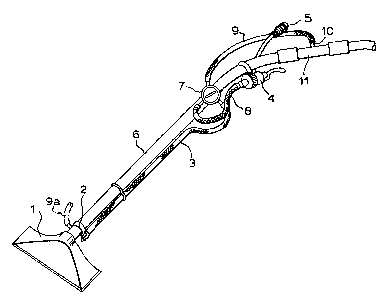Some of the information on this Web page has been provided by external sources. The Government of Canada is not responsible for the accuracy, reliability or currency of the information supplied by external sources. Users wishing to rely upon this information should consult directly with the source of the information. Content provided by external sources is not subject to official languages, privacy and accessibility requirements.
Any discrepancies in the text and image of the Claims and Abstract are due to differing posting times. Text of the Claims and Abstract are posted:
| (12) Patent: | (11) CA 1264511 |
|---|---|
| (21) Application Number: | 1264511 |
| (54) English Title: | VACUUM CLEANING APPARATUS |
| (54) French Title: | ASPIRATEUR |
| Status: | Expired and beyond the Period of Reversal |
| (51) International Patent Classification (IPC): |
|
|---|---|
| (72) Inventors : |
|
| (73) Owners : |
|
| (71) Applicants : |
|
| (74) Agent: | MARKS & CLERK |
| (74) Associate agent: | |
| (45) Issued: | 1990-01-23 |
| (22) Filed Date: | 1985-02-07 |
| Availability of licence: | N/A |
| Dedicated to the Public: | N/A |
| (25) Language of filing: | English |
| Patent Cooperation Treaty (PCT): | No |
|---|
| (30) Application Priority Data: | ||||||
|---|---|---|---|---|---|---|
|
ABSTRACT
An improvement in the dry vacuum cleaning of soft
and hard surfaces in which vacuum only is applied to
such surface, is characterised in that dry soil flowing
away from such surface under the influence of vacuum is
sprayed with liquid and deposited in a wetted condition
in a liquid and soil-collecting vessel.
Also proposed is apparatus for cleaning hard and
soft surfaces by simultaneous application thereto of
liquid and vacuum using a tool and which is equipped
with a conversion device to permit dry vacuum cleaning
with entrainment of dry soil in the liquid for
subsequent collection in a soil and liquid vessel. The
device comprises a 2-way valve by which
liquid flowing through a first pipe can be caused to
flow alternatively to a head of a tool, or, through
at least one branch pipe to a second pipe or
pipe insert by which suction is applied to the head
of the tool to entrain the dry soil flowing therein.
The branch pipe or pipes normally terminate in one or
more spray nozzles and may be located at various
different positions in the path of flow of the dry soil
induced by vacuum.
Note: Claims are shown in the official language in which they were submitted.
Note: Descriptions are shown in the official language in which they were submitted.

2024-08-01:As part of the Next Generation Patents (NGP) transition, the Canadian Patents Database (CPD) now contains a more detailed Event History, which replicates the Event Log of our new back-office solution.
Please note that "Inactive:" events refers to events no longer in use in our new back-office solution.
For a clearer understanding of the status of the application/patent presented on this page, the site Disclaimer , as well as the definitions for Patent , Event History , Maintenance Fee and Payment History should be consulted.
| Description | Date |
|---|---|
| Time Limit for Reversal Expired | 2005-01-24 |
| Letter Sent | 2004-01-23 |
| Grant by Issuance | 1990-01-23 |
There is no abandonment history.
| Fee Type | Anniversary Year | Due Date | Paid Date |
|---|---|---|---|
| MF (category 1, 8th anniv.) - small | 1998-01-23 | 1998-01-20 | |
| MF (category 1, 9th anniv.) - small | 1999-01-25 | 1998-12-24 | |
| MF (category 1, 10th anniv.) - small | 2000-01-24 | 2000-01-17 | |
| MF (category 1, 11th anniv.) - small | 2001-01-23 | 2000-12-29 | |
| MF (category 1, 12th anniv.) - small | 2002-01-23 | 2002-01-10 | |
| MF (category 1, 13th anniv.) - small | 2003-01-23 | 2003-01-20 |
Note: Records showing the ownership history in alphabetical order.
| Current Owners on Record |
|---|
| STEAM VACUMM EXTRACTION LIMITED |
| Past Owners on Record |
|---|
| DEREK ASHBY |
| RAYMOND JOHN FORWARD |
| SAJJADALI GHULAMALI ALI |